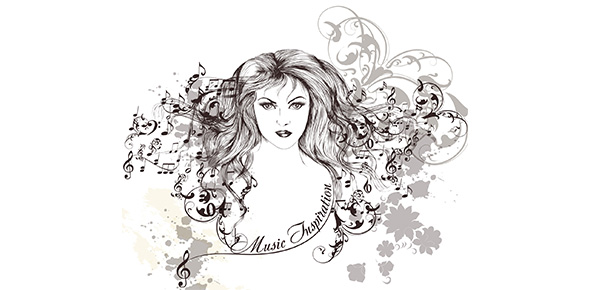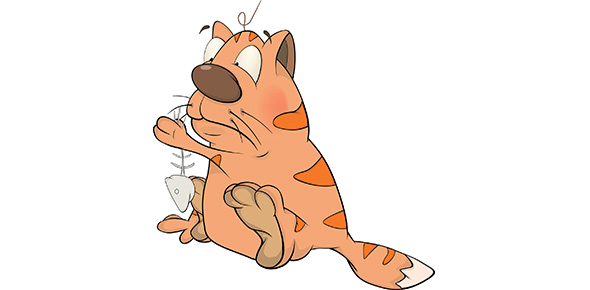Related Flashcards
Related Topics
Cards In This Set
| Front | Back |
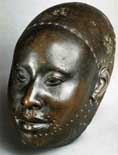 Yoruba |
Yoruba, Ife, "Obafulon" mask 12-15th c. Nigeria Bronze. This bronze cast head is of an early ruler Obalufon, an Oni, the ruler at Ife. This mask shows the Oni Obalufon who was a great leader and is said to have introduced bronze casting to Ife. This may have been worn for a ceremony of enthronement by a new leader because Obafulon has been used for transfer of leadership. The lineage continues an Oni stills hold sway over the Yoruba at Ife today. The dots and holes around the mouth are thought to be where animal skins were attached to represent a beard. It demonstrates coolness and an idealized manner of comportment. The slits at the eyes mark this as an object to be worn over the face as a mask.
|
 Yoruba |
Yoruba, Ife, Figure of an Ooni, 12th-15th c. Nigeria
Emphasized head to denote coolness and the seat of sprituality and temperence. The clothes are important because they too show inner character.
Ife was the center of as many as 400 religious cults whose traditions were manipulated to political advantage by the oni (king) in the days of the kingdom's greatness. Ife also lay at the center of a trading network with the north. The oni supported his court with tolls levied on trade, tribute exacted from dependencies, and tithes due him as a religious leader. One of Ife's greatest legacies to modern Nigeria is its beautiful sculpture associated with this tradition.
The oni was chosen on a rotating basis from one of several branches of the ruling dynasty, which was composed of a clan with several thousand members. Once elected, he went into seclusion in the palace compound and was not seen again by his people. Below the oni in the state hierarchy were palace officials, town chiefs, and the rulers of outlying dependencies. The palace officials were spokesmen for the oni and the rulers of dependencies who had their own subordinate officials. All offices, even that of the oni, were elective and depended on broad support within the community. Each official was chosen from among the eligible clan members who had hereditary right to the office. Members of the royal dynasty often were assigned to govern dependencies, while the sons of palace officials assumed lesser roles as functionaries, bodyguards to the oni, and judges.
During the fifteenth century, Oyo and Benin surpassed Ife as political and economic powers, although Ife preserved its status as a religious center even after its decline. Respect for the priestly functions of the oni of Ife and recognition of the common tradition of origin were crucial factors in the evolution of Yoruba ethnicity. The oni of Ife was recognized as the senior political official not only among the Yoruba but also at Benin, and he invested Benin's rulers with the symbols of temporal power.
|
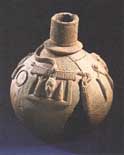 Yoruba |
Yoruba, Ife, Ritual vessel, 13th-14th c., Nigeria
The head of the Oni is depicted with two abstract heads which represent inner essence with an altar. A snake is features coming into the head/altar of the oni. Snakes are magical beings that can exist on two planes. Animals that travel in different elements i.e. earth & water, earth & sky are oftern associated with the ability to do between the spiritual and material worlds. The hole on the bottom of the vessel was always there which suggests it was used to pour special liquids through it, giving it mystical power and into the earth as a sacrificial offering.
|
 Yoruba |
Yoruba, Ife the 24th Oba of Ila, 1980's Nigeria
The heavy clothin mark the king as a prisoner of the title. His face is obscured to emphasize the position of Oba rather than the individual and if one were to look at him in the face it would be too powerful. King is in the middle of the living and the dead. The birds on the crown symbolize the powers of women and witchcraft and are also symbols of Osanyin and his herbs which repel their magic. His wife is responsible for putting on and taking off the crown because if the kind were to look inside and see the magical herbs placed inside he would be overwhelmed. The faces on the crown allude to Oduduwa the founder of the Yoruba and its kingship who was also a god. The crown is heavy and expensive to make which speaks to its symbol of kingship and power.
|
 Yoruba |
Yoruba Ogboni Couple (staffs) 19th c. Nigeria
They are placed into the ground in front of an ogboni shrine which is a fraternal secret society which choses and can removed the Oba/Oni. Ogboni lodges were one of the main commissioners of brass jewelry and sculpture in pre-colonial Yorubaland, using the metal's rust-resistant qualities as an apt metaphor for the immortal functions and beliefs of Ogboni adepts.The most recognizable of these symbols was a pair of Ogboni initiates, one male and one female, attached by a chain and worn around the neck. The pair are thought to symbolize the attachment of the sexes in procreation and balanced society. Generally, one or both figures will hold a thumb in the grip of the opposite hand, demonstrating the paramount Ogboni handsign denoting initiation and membership.
|
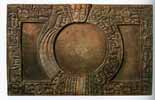 Yoruba |
Yoruba, Ifa divination tray 17th c.Republic of Benin
Ifa is the Yoruba system of divination. Eshu is featured at the top and is marked by the phallic headdress. Other figures allude to divination as well. Ifa and Eshu share responsibilities. They are both at the border of earth and warer. Ifa has 256 categories of knowledge - each has its own phonetic oral system.
Special instruments are used to assist in the divination to transcribe Orunmila's wisdom through the diviner. The items used for divination include:
|
 Yoruba |
Yoruba, Eshu Dance Wand, Collected in 1958, Nigeria. Composed face, phallic head, lots of cowrie shells, Eshu is the trickster god, rules over language and the arbitrary nature of communication. He is said to wear a red and black hat and walk between people to cause an argument about the color of the hat. He tricks people. Sometimes he is painted purple or indigo which is a royal symbol and one of weath. Eshu was glutonous god who at his mother and when he was about to eat his father he was struck into several pieces of laterite by his father and cast about the earth. He sucks his thumb in some depictions. He is the Enfant Terrible and some western scholars draw connections to "the devil"
|
 Yoruba |
Yoruba, Shango shine figure, 19th c. Nigeria
Shango is the god of thunder who burned down his house killing his wife and family when he was playing with lightning. So distraught he hung himself from a tree outside his home. His friends and family came to the sight and began to worship him - he became a god. He is an example of what can happen when one looses their cool/calm head. Sculptures for Shango often have women. The double ax shape on her head represents the meteorite or thunder rocks of Shango.
|
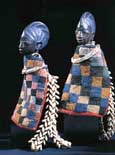 Yoruba |
Yoruba Ibeji figures, Nigeria
Yoruba are thought to have the highest rate of twin births in the world. Twins are special. They stand in for a deceased twin and are meant to be cared for like a child - clothed, fed etc., Ibeji is the deity of twins. Different hair styles, scarification, figure shape and style of carving indicate the origin of a figure. Often dressed and fed, some still have their special robes.
|
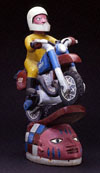 Yoruba |
Eloi Lokossou is a prolific Yoruba artist who creates works for one of two Gelede dance societies in Cové, in the south central Benin Republic. The proud young man portrayed riding a Honda motorcycle makes a statement about wealth, status, and modernity. At a deeper level, the mask refers to Ogun, the Yoruba god of iron-and hence devices like motorcycles made from metal and associated with the violence of change. Further allusion is made to the mystical powers of ”our mothers,” as depicted in the placid face of a woman in the mask’s lower register, for they mystically assure innovation as eye-catching as this shiny new motorcycle
|
 Yoruba |
Yoruba, Palace Doors early 20th c. Osi-Llorin Nigeria. Sculptor Arowogon (1880-1954) king in profile seated, eshu about to grab his crown, shows his playfulness and greed also on a bike on each door going in opposite directions. often seen w/ Pipe, Doors are sign of traditional and modern authority.
|




